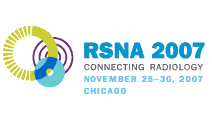
Abstract Archives of the RSNA, 2007
SSA01-09
Magnetic Resonance Galactography: Initial Clinical Experience
Scientific Papers
Presented on November 25, 2007
Presented as part of SSA01: Breast Imaging (MR Imaging)
Evelyn Wenkel, Presenter: Nothing to Disclose
Siegfried Schwab MD, Abstract Co-Author: Nothing to Disclose
Rolf Janka MD, Abstract Co-Author: Nothing to Disclose
Michael Uder MD, Abstract Co-Author: Nothing to Disclose
Rüdiger Schulz-Wendtland, Abstract Co-Author: Nothing to Disclose
Werner A. Bautz MD, Abstract Co-Author: Nothing to Disclose
Magnetic resonance (MR) imaging can be used in the diagnostic workup of pathological nipple discharge. Few cases have been reported about indirect galactography (iMRG), visualizing the existing fluid in the pathological mammary ducts. Purpose of our study was to evaluate the usefulness MR galactography (MRG) with or without intraductal contrast material (CM) injection.
24 women with pathological nipple discharge underwent physical examination, ultrasound, conventional galactography (CG) and MR imaging before surgery. Our standard MR protocol of both breasts consists of T2 weighted images, T1 non contrast and contrast enhanced images in two different planes and dynamic studies. For MRG high resolution 3D-T1 and 3D-T2 weighted sequences of the affected breast were performed before (iMRG) and after (dMRG) gadolinium DTPA was injected into the discharging duct. MR findings were analyzed and compared to CG and histological reports. Pathological findings in galactography were defined as ductal cut off, ductal wall irregularities, extravasation of CM, simple and cystic ductectasia and filling defects. Pathological findings in CG served as gold standard.
Histology revealed simple cystic disease in 6 patients, single or multiple papillomas in 13 patients and DCIS or carcinoma in 5 patients. CG was classified as pathological in all patients with a total of 57 pathological findings. 3D-T1 weighted high resolution dMRG was pathological in 19 cases (79%) with a total of 37/57 (64%) findings. 3D-T2 weighted high resolution dMRG was pathological in all cases (100%) with a total of 47/57 (82%) findings. In 20 patients iMRG was performed with a high resolution 3D-T2 weighted sequence . IMRG was pathological in 10/20 cases and showed 14/46 (30%) pathologies. No severe side effects were observed.
MR galactography is a useful and safe method in the workup of pathological nipple discharge. DMRG showed more pathologies than iMRG. The highest sensitivity for ductal pathology compared to CG was found in the high resolution 3D T2 weighted sequence.
MRI can eventually replace standard conventional galactography and reduce radiation exposure of patients.
Wenkel, E,
Schwab, S,
Janka, R,
Uder, M,
Schulz-Wendtland, R,
Bautz, W,
Magnetic Resonance Galactography: Initial Clinical Experience. Radiological Society of North America 2007 Scientific Assembly and Annual Meeting, November 25 - November 30, 2007 ,Chicago IL.
http://archive.rsna.org/2007/5014862.html

